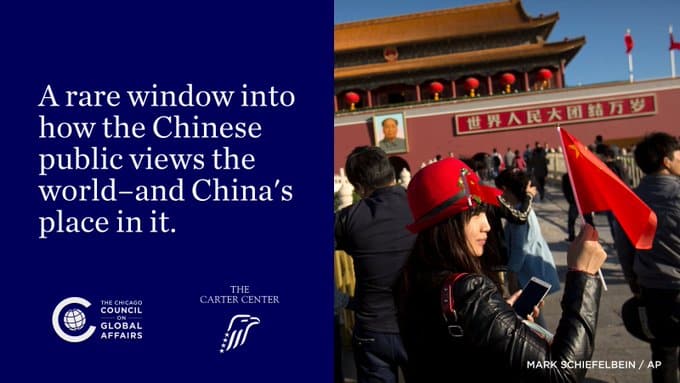Taking Down “Made-in-China” Cranes Cannot Address U.S. Weakness in The Shipping Industry
- Analysis
 Yilun Zhang
Yilun Zhang- 03/19/2024
- 0
Yilun ZHANG is a Research Associate at the Institute for China-America Studies (ICAS). He is also the manager of the ICAS Trade ’n Technology (TnT) program and the ICAS Maritime Issue Tracker Project. His key area of research pertains to the U.S.-China strategic competition on security and trade and technology; major power relationships in East Asia and the Indo-Pacific region; and U.S. legislation and its implications to U.S.-China bilateral relationship.
He holds a Master’s degree in International Relations with a concentration on international political economy from the Johns Hopkins School of Advanced International Studies. His bachelor’s degree was awarded by the School of International Studies at the American University.
Just a little more than a year since the notorious “Chinese balloon incident,” a congressional probe of Chinese-built cargo cranes revealed the shocking finding last week that there was communications equipment emplaced within the cranes that did not appear to support normal operations. The Chinese company that produced the cranes, the Shanghai Zhenhua Heavy Industries (ZPMC), denied the findings and called the probe “misleading.”
The question of whether Beijing is actually spying on Americans via various day-to-day equipment and products is already taken to be a fact within the Beltway, whether there is evidence or not. It will undoubtedly fuel an already mounting fear over China’s threat to American national security. That concern for safeguarding American national security, however, is now misaligned with the pursuit for American competitiveness.
Similar to the other espionage cases over Huawei’s equipment and ByteDance’s TikTok app, the current attention and actions on Chinese-built cargo cranes are driven by zero-sum thinking that produced a chaotic mix of national securityand economic competitiveness concerns. To those in Washington who seek to win the U.S.-China strategic competition, reliance on China means exposing American vulnerability to Beijing, who will definitely leverage that to make the U.S. lose.
From a supply chain perspective, however, the U.S. has already lost the shipping competition. Such zero-sum thinking produces nothing but unrealistic paranoia.
The Biden administration’s concern over America’s “overreliance” on Chinese cranes is merely the tip of the iceberg. The U.S. is reliant on China across the entire maritime supply chain. From shipbuilding to container manufacturing, and from shipping services to port services, China plays a central role in every sector. It has reportedly been the world’s largest shipbuilder for 13 consecutive years. Over the last two decades, the number of Chinese shipyards grew from less than 10% of the total global market share to over 50% by the end of 2023. On the other hand, over the past five decades, U.S. shipbuilding has declined from the top of the world to less than 1% of the world.
China is also the world’s largest shipping container manufacturer. China’s state-owned China Ocean Shipping Company (COSCO) is the world’s 4th largest shipping company. The shipping giant formed an alliance with the French CMA-CGM (the 3rd largest), the Taiwan-based Evergreen (the 7th largest), and the Hong Kong-based OOCL. Out of the top 20 global shippers, none are based in the United States while three are based in mainland China. China also leads in global port services. China reportedly has stakes in 44 ports abroad. Domestically, China operates seven out of the world’s 10 busiest container ports.
China’s dominance in the global maritime supply chain is a result of its continued investment and support of the shipping industry. Although its government subsidy came under criticism in the West, the U.S. shipping industry has been asking for the exact same kind of government subsidies. Industry leaders, back in 2022, proposed that the U.S. should enact a U.S. Ships Act, similar to the CHIPS and Science Act, that provides financial and other support to “help American shipbuilders and shipping companies reclaim lost ground in international markets.”
China is also not the cause for America’s decline in the global shipping supply chain. Prior to China’s rise in the global shipping supply chain, Japan and South Korea had also surpassed the U.S. and took center stage in different sectors of the global maritime supply chain since the 1980s. America’s own lack of competitiveness is the root cause of its “overreliance” on China. Addressing this economic issue requires a comprehensive national infrastructure and research and development (R&D) investment strategy to revive American domestic capacity and thereafter adjusting the global supply chain accordingly through market force, not by security-oriented tariffs that only bring disruption.
The spy crane investigation is only one of the measures of a larger U.S. attempt to revive its domestic shipping supply chain. But using security concerns to push for economic reform does not necessarily align with economic common sense. To address the spy crane concern, the U.S. government plans to invest 20 billion USD to support domestic crane production by a U.S. subsidiary of Mitsui, a Japanese company. Billions of U.S. taxpayer dollars will not make the U.S. a winner in the shipping crane battle; it will simply shift America’s reliance on China to Japan.
This week, the U.S. steel union also seized the momentum to call for an expanded Section 301 investigation on China’s economic practices in the shipbuilding and maritime logistics sector. But following nearly six years of tariffs and sanctions, the current U.S.-China trade impasse already revealed that protectionist tariffs do not help addressAmerican competitive weaknesses. Even United States Trade Representative (USTR) Ambassador Katherine Tai contended that tariffs are not sufficient to address some of the key issues and has called for new tools to better compete with China on trade.
Tariffs did narrow U.S. trade deficit with China to its lowest level since 2010. But it did not eliminate the deficit, which still lies at over 270 billion USD. Moreover, as a recent Xeneta finding shows, despite a sharp drop of goods shipped directly from China, many Chinese shipments now make their way to the U.S. via Mexico. This has made Mexico the biggest exporter of goods to the U.S. in 2023, which increased the U.S. trade deficit with Mexico by 17%. The security-oriented 301 tariffs not only failed to reduce U.S. reliance on China, but also caused more problems for managing its North American free trade relationship with its southern neighbor.
The U.S. Congress has also prepared both the initial toolkit for Washington to go after Beijing on shipping and the enforcement means in the form of a supercharged Federal Maritime Commission (FMC). The Ocean Shipping Reform Act of 2022 and the subsequent Ocean Shipping Reform Implementation Act of 2023 gradually expanded the authority of the FMC with a specific aim at foreign shipping companies—particularly Chinese companies—to address “the United States’ longstanding trade imbalance with China and other countries.” It is also worth noting that in the originally proposed text of the Ocean Shipping Reform Act of 2022 the FMC is required to carry out its actions “in harmony with fair and equitable international shipping practices.” Meanwhile, in the final version, which President Biden signed into law on June 16, 2022, this line has been expunged. Intentional or not, the absence of this important restraint implies that Washington’s future actions on shipping could become as disruptive, “unruly and self-interested” as its current trade practices vis-a-vis Beijing.
The spy crane probe has brought momentum to raise public awareness and rally public support for the U.S. shipping industry. But instead of following economic common sense and building back a better U.S. shipping industry, current policies are only leading to taxpayer dollar waste and disruption in the global shipping supply chain. The fear of China posing a national security threat only produces paranoid and abrupt reactions, while the industry, which is in desperate need of long term strategic support, continues to wander by in limbo.
This article does not represent the views of The Carter Center’s U.S.-China Perception Monitor.







